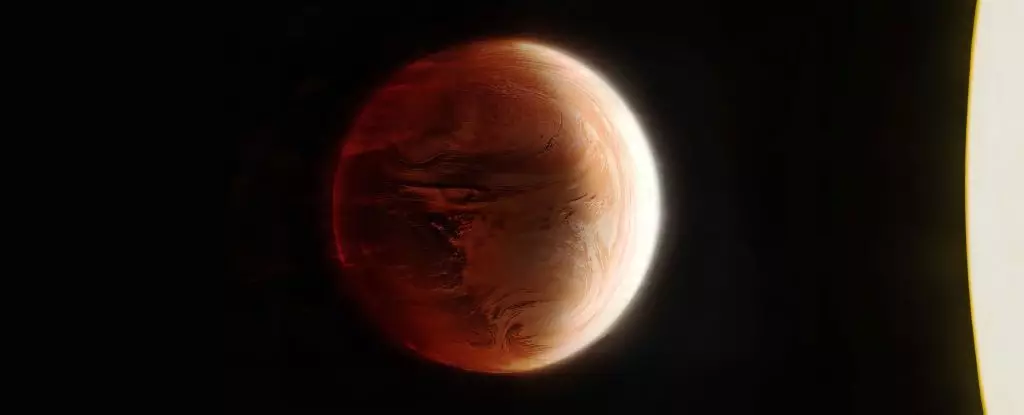Tylos, scientifically designated as WASP-121b, is a fascinating astronomical object located approximately 880 light-years from Earth, probing the very boundaries of our understanding of planetary atmospheres. This extreme exoplanet, categorized as a “hot Jupiter,” offers an extraordinary case study due to its extreme proximity to its host star, resulting in staggering temperatures and bizarre atmospheric phenomena that defy typical weather patterns found within our Solar System.
Hot Jupiters like Tylos are gas giants that orbit extraordinarily close to their stars, resulting in their surface temperatures soaring far beyond those of any traditional celestial body. Tylos stands at nearly 1.74 times the radius and 1.16 times the mass of Jupiter but experiences conditions that, by comparison, are almost cosmic in their intensity. With a temperature reaching up to around 2,360 Kelvin (approximately 2,087 degrees Celsius), Tylos presents an environment so extreme that it vaporizes metals, creating clouds rich in iron and titanium. As surprising as it may sound, it even rains liquid gemstones—sapphires and rubies—adding to its enigmatic allure.
Recent studies have led to a groundbreaking reconstruction of Tylos’ turbulent atmosphere in three dimensions, revealing records of wind speeds previously thought impossible. Utilizing the combined capabilities of the European Southern Observatory’s Very Large Telescope, a team of scientists, including astrophysicist Julia Victoria Seidel, worked diligently to analyze Tylos’s atmospheric dynamics. Remarkably, their findings indicated that winds within Tylos’ atmosphere can reach staggering speeds, with some measurements clocking in at about 26.8 kilometers (16.7 miles) per second during specific patterns.
Such velocities eclipse even the most severe storms observed within our own Solar System, suggesting a level of meteorological complexity that prompts further inquiry into atmospheric behavior on exoplanets. The developing model articulates distinct jet streams that circulate along the equatorial regions, a phenomenon previously unobserved in other planetary atmospheres. This distinct atmospheric layering features super-rotational winds situated at various altitudes, a result of the extraordinary heat and evolving thermal dynamics at play.
The atmospheric conditions on Tylos stretch beyond traditional meteorological boundaries, prompting scientists to rethink their conceptual frameworks regarding how weather functions on planets. The concept of tidal locking, wherein the same side of Tylos perpetually faces its star, generates a stark thermal dichotomy. This duality creates an intense contrast in temperatures between the perpetually lit day side and the shadowed night side, generating powerful atmospheric currents.
The rapid fluctuations in temperature observed—amounting to nearly 950 Kelvin—between the morning and evening hours not only highlight the planet’s atmospheric instability but also illustrate how thermal energy fosters supersonic wind speeds. Such speeds and atmospheric dynamics present a stark contrast to hurricanes on Earth, which seem tame by comparison. The extraordinarily variable environment showcases a climate that is far removed from any terrestrial experiences.
As researchers disentangle the complex layers of Tylos’ atmosphere, their work illuminates a path forward for exoplanet exploration. Each new layer of understanding provides critical insights into the chemical composition, weather patterns, and elemental behavior within this distant world. The revelation that Tylos’ atmosphere is continually leaking gases into the void of space inspires questions about the longevity of such extreme exoplanets.
The implications for future astronomical studies are profound. With nearly 6,000 confirmed exoplanets cataloged within the Milky Way, Tylos stands out as a crucial reference point, demonstrating the remarkable diversity of planetary atmospheres and their possible behaviors. As researchers, like Bibiana Prinoth of Lund University, assert, the ability to dissect the atmospheric makeup and weather phenomena of such distant worlds is indeed revolutionary and hints at the exciting possibilities that lie ahead in exoplanetary science.
Tylos represents both a scientific marvel and a mesmerizing mystery, pushing the boundaries of our knowledge about exoplanetary conditions and the potential for diverse planetary systems throughout the cosmos. It remains an emblem of our expanding quest to comprehend the mysteries of the universe.

